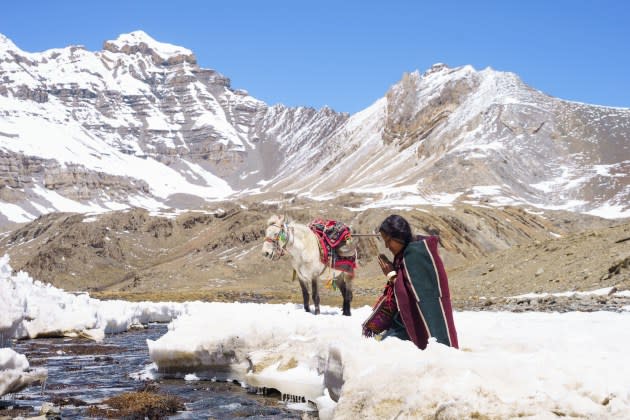‘Shambhala’ Review: A Tranquil but Meandering Mountain Journey

Little delights abound in “Shambhala,” Min Bahadur Bham’s Berlinale competition entry, in which a vibrant young Nepali woman, Pema (Thinley Lhamo), enters into a polyandrous marriage with her lover, Tashi (Tenzin Dalha), and his two younger brothers. Bham’s tale, a physical and spiritual journey, is catalyzed by Tashi’s disappearance and Pema’s subsequent search to find him. However, at two-and-a-half hours in length, the film’s meticulous unfurling ends up spread across alternating peaks and valleys of interest and emotional allure, rendering its careful compositions only semi-affecting.
Bham paints Pema’s rural Himalayan village with whimsical brush strokes, framing the rural perspectives and traditions with a sense of mischievous intimacy. Pema’s parents joke about her marrying three brothers — a nominal arrangement, since she’s in love with one of them — and they hope, against local expectations, that she’ll be treated well. However, they don’t seem to really worry, placating audiences who might be unfamiliar with the setting. Even when it turns out one of the brothers, Dawa (Karma Wangyal Gurung), is a child, there’s little cause for concern, since Pema’s relationship to him is distinctly maternal.
More from Variety
The relationships between Pema and Tashi, Dawa and middle brother Karma (Sonam Topden) — a monk whose ascetic vegetarianism and refusal to ride horses ends up the butt of everyone’s jokes — have a soothing quality. When Tashi embarks on a months-long trade journey, his jovial presence, and the comfort and physical chemistry he shares with Pema, are conspicuous by their absence. However, when rumors abound regarding Pema’s pregnancy (which the gossipy townsfolk attribute to Dawa’s schoolteacher), news of Tasha abandoning his post reaches Pema, spurring on her journey across the rural landscape with Karma’s help.
While Bham ensures chuckles and smiles during the initial hour — often through sudden cuts that punctuate surprising humor — the film’s visual energy shifts dramatically from there on out, once Pema embarks to find Tashi and confront him with the truth. “Shambhala” is, by its nature, prismatically split between two modes of storytelling: the jovially human, and the spiritual and abstract, as the wide-open mountainside becomes a site of reflection and discovery. However, despite the keen eye Bham brings to the latter, with his leisurely lateral tracks and pans across space, the camera’s movement rarely reveals anything beyond the snow-capped peaks.
The title “Shambhala” refers to a place of tranquility, a realm that occasionally materializes in characters’ sepia-toned dreams and visions (usually of Karma’s rinpoche, or spiritual mentor). The film’s literal reality is tranquil too: Its depiction of nature is picturesque, though perhaps a greater contrast or dichotomy between the real and the imaginary may have given Pema’s journey a sense of wonder or spiritual purpose. The film’s landscapes are seldom matched by either inner beauty, or by moral complications.
The nuances of Pema’s sisterly dynamic with Karma are intriguing to watch, especially since he ends up torn between his monastic and brotherly duties (and he may have even been convinced by the local rumors). But when it comes to the movie’s spiritual rigor, its eye-popping compositions become too careful and confined. Lhamo’s screen presence proves magnetic, but beyond a point, Pema is granted no emotional veil for the camera to pierce.
“Shambhala” does, essentially, what it says on the tin. Its landscape may be mountainous, but its emotional trajectory is a distinct plateau. While it reveals a surprisingly feminist vision of contentment, spirituality and the social expectations women are forced to shoulder — the burden of proof always lies on Pema, and never on those casting aspersions on her character — the film seldom wrestles with its own convictions, or forces Pema to do the same.
Best of Variety
Sign up for Variety’s Newsletter. For the latest news, follow us on Facebook, Twitter, and Instagram.
Solve the daily Crossword

